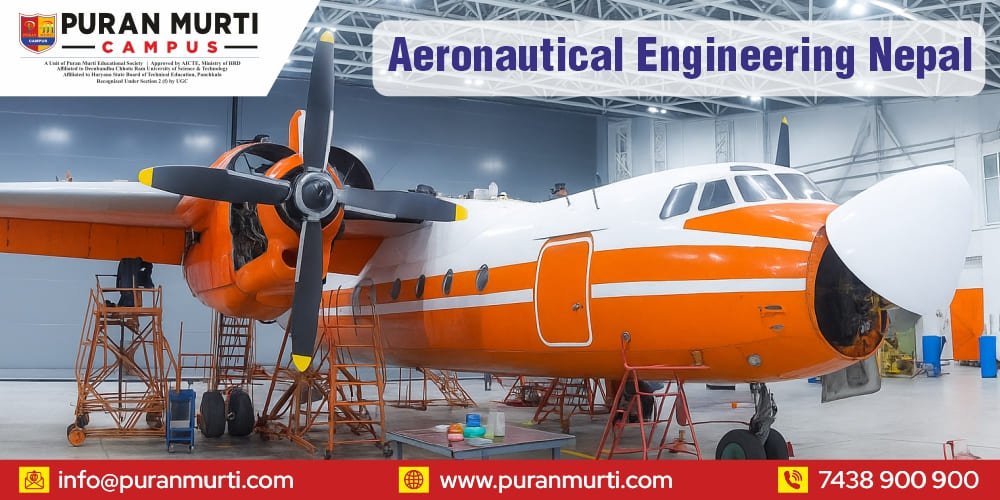Aeronautical Engineering Nepal
Posted on : 14 November, 2025 3:45 pm
In the backdrop of Nepal’s beautiful landscapes, I set out for a learning journey aiming at understanding what exactly is being offered in Aeronautical Engineering Nepal aircraft/aerospace engineering studies as of today in Nepal, India, and the nearby region. Apply Now
Future dreameres who are passionate about aircraft, propulsion, and the spacecraft designs often express their curiosity: Could I possibly take aeronautical / aerospace engineering as my subject? Well, there are few (very few) local options available, and a large percentage of students from Nepal end up preferring other specialized colleges in India, one of the common options being Puran Murti Campus (Delhi NCR/Sonepat) Apply Now
Here’s the past and the present scenario of Nepal.
-
The study available in Nepal for aerospace /aeronautical degrees is minimal. The foremost Nepalese institution to offer a programme is the Bachelor Program in Engineering, located at Pulchowk campus under the Institute of Engineering, Tribhuvan University. The seats are very limited and competition is stiff. Other Nepalese engineering colleges focus mainly on basic engineering branches (Civil, Mechanical, and Electrical engineering) rather than aviation.
Image of a course
Should you land in military training in Nepal or in some specialized college in India, the aircraft / aeronautical undergraduate program will obviously be about the following:
-
Duration & credits: 4 years (8 semesters) for a B.Tech/BE/B.E. or B.Sc. in aerospace/aeronautical engineering.
-
These modules are standard: Aerodynamics, Aircraft Structures, Propulsion, Flight Mechanics, Avionics, Materials for Aerospace, Aircraft Systems, Control & Stability, Thermodynamics, Fluid Mechanics, and Aircraft Maintenance (for AME programs). Apply Now
-
Lab & practicals: wind tunnels, propulsion labs, material exhibits/test rigs, CAD/CAE setups, simulators, and hands-on working in aircraft components/lab. Real exposure in the laboratory is essential for employability enhancement.
Nepali student options: study in nearby Nepal Apply Now
Study near Nepal (India — GPS Puran Murti Campus)
-
Puran Murti Campus (Delhi-NCR/Sonepat), on the other hand, is, for the sake of Nepal’s students who are willing to have a purely focused higher-level education in aeronautics/aerospace, clearly aiming at practical workshops, simulated aircraft training, and maybe also integrating AME (DGCA) license training along with a B.Tech degree ( dual academic and license pathway). The college offers a blend of rigors of academia with the hands-on training for graduates as far as aircraft maintenance goes in order to make them MRO- or airline-ready. Apply Now
-
This is why students are drawn to these colleges: much better hands-on facilities, AME licensing in-built competency (good for careers in maintenance), placements and internships running toward airlines and MROs, and, again, it being located nearby; a shorter relocation besides being culturally familiar.
For Example: Puran Murti Campus programs offered
-
Programs: B.Tech in Aeronautical Engineering or Aerospace Engineering (4 years). They also design integrated AME (DGCA) + B.Tech models (license+degree, actually).
-
Hands-On Training: For the hands-on training in models of the actual aircraft, simulators, and maintenance workshops to inculcate readiness for MRO or airline. Apply Now
-
Fees (indicative): Puran Murti Campus pages and listings in an agency show approximate fees on per semester or aggregative basis, for example: on such a dot point, a college page articles INR 62,500 per semester; however, dummy have floated around in total tuition ranges that are provided (for instance ₹6.0 lakh total; always check with the campus for actual break-downs and any scholarship, or hostel expenses). Always confirm with the campus back if you need to know what the current fees are.
Admissions
-
Eligibility tests: A common norm: 10+2 (or equivalent) with Physics, Chemistry, and Mathematics (PCM) and a minimum aggregate obtained during senior high (varies from institution to institution). For Nepalese students, outside institutions demand certificates of equivalence between countries. Apply Now
-
Examinations: Some institute entrance exams and may accept selections based on national/state-level engineering tests (or direct entry based on 10+2 marks). For real AME practical training (now required for licensing), some aptitude testing would further need to be passed before license issuance as per DGCA standards. Apply Now
Career prospects after aeronautical/aerospace degree
-
Aircraft Design & R&D (aerospace companies, research labs)
-
Airline operations & flight/technical support (technical officers, ground engineering)
-
MROs — you can directly work on maintenance if you hold an AME license (DGCA), the third-largest field in demand on an international market.
-
Defense & Government Aviation Sectors (when eligible)
-
Additional studies: M.Tech/MS abroad, specialization in avionics, or propulsion research studies.
-
One thing to remember is that the integrated degree-AME license combinations are desirable to the airlines and MROs; it shows a level of formal engineering education followed by practical maintenance qualification. Apply Now
Steps for Nepali Students
| Step | What to Do |
|---|---|
| Step 1 | Complete your +2 Science with Physics, chemistry and Mathematics. |
| Step 2 | Prepare for entrance exams like JEE (if studying in India)/(AME CET) is national level exam for aerospace/aeronautical engineering. |
| Step 3 | Apply to colleges like Puran Murti Campus or other AICTE-approved institutes. |
| Step 4 | Apply for student visa and scholarship opportunities. |
| Step 5 | Start your journey toward becoming an Aeronautical Engineer! Apply Now |
Final thoughts
Aeronautical and aerospace careers are absolutely achievable for Nepali students — but realistic planning is key. Many students find a strong middle path by studying at specialised nearby campuses (like Puran Murti Campus) that combine degree-level academics with practical aircraft maintenance training and industry ties. Decide early: do you want maintenance (hands-on AME), design & research, or operations/airline roles? That choice should guide whether you pursue an AME-integrated program, a pure engineering degree, or postgraduate specialization. Apply Now


